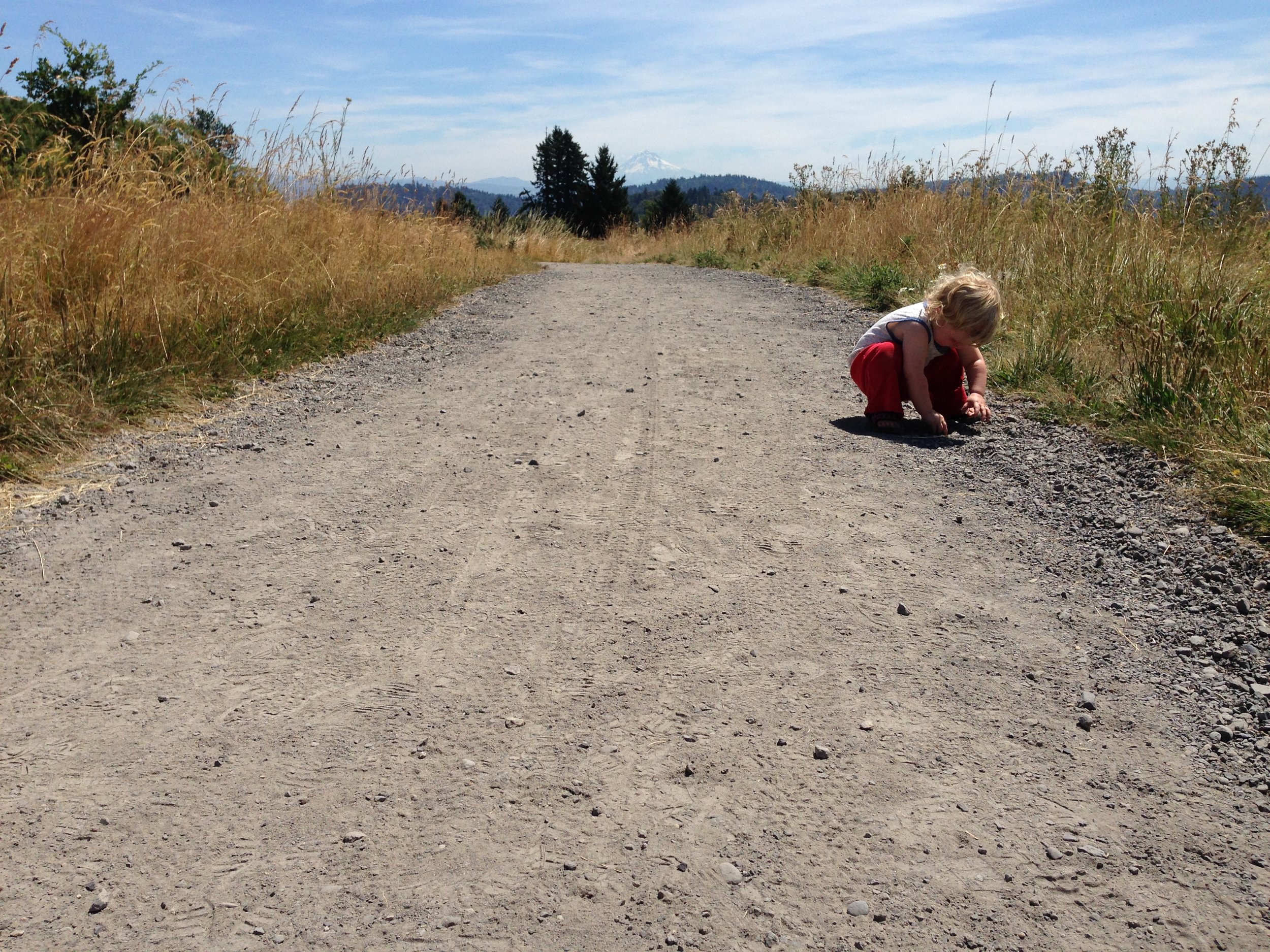7. Set limits with snacking
I recognize that there are many different approaches to feeding children but constant snacking, or “grazing,” and being allowed to run and play while eating (both at home and especially out in the community) can prevent kids from fully engaging with either their environment or the experience of eating. Children crave limits about food, even—or especially—if their behavior says otherwise. If they trust that you will offer diverse, nutritionally balanced (protein + fat + carbohydrate), and filling snacks at regularly scheduled intervals they can relax about food. They eat if they’re hungry, don’t if they’re not and then... move on. Snack and mealtimes can become more challenging when we’re out and about (especially when we’re without access to the clear structure of a table and chair) but young children are quite capable—with consistent expectations—of sitting down to enjoy their food and the company of their parent or caregiver. Bringing along small wooden, plastic or stainless steel plates or bowls, utensils and cloth napkins can add welcome structure and ceremony to snacks enjoyed outside while giving the whole affair the air of a picnic—both special and civilized.
There are many benefits that come with setting limits with grazing and implementing structured snack times. First, children who are hungry without becoming ravenous are more willing to try new foods and eat more at meals than the child who is never able to build an appetite throughout the day. Second, by expecting children to sit while they eat (and sitting with them) we are allowing children opportunities to practice appropriate mealtime behavior while simultaneously modeling it ourselves. Third, we’re promoting mindful eating, a practice that offers a host of benefits by tapping into young children’s intuition about their bodies’ cues for hunger and fullness.
Ellyn Satter, a registered dietician and renowned authority on the subject of child nutrition who pioneered the concept of division of responsibility in feeding, explains,
“I realize that even for some adults not being able to eat on demand—to graze constantly for food—seems like cruel and inhuman punishment. It’s not—it’s merely making it possible for your child to be successful with eating. Keep in mind the importance and role of the planned snack... Don’t let her run around the house to eat: it’s dangerous, it’s grazing instead of having a planned snack, and it makes a mess. Sit down with her to keep her company.”
-Child of Mine: Feeding with Love and Good Sense
8. Know when it’s time to leave
This one is tricky because it usually involves making a unilateral decision that can feel uncomfortable for many parents and caregivers, especially those committed to a gentle, respectful parenting style characterized by lots of communication and jointly-made decisions. It can be difficult to know whether a child is simply discharging some of the big feelings that come with early childhood (or simply being a human for that matter) like disappointment or frustration or whether they’ve crossed over into a place of being too tired, too overwhelmed, and too overstimulated from which they will likely not return until they’ve had some quiet time at home to regroup (which may involve a meal, a nap, or snuggles and books with someone they love). This is not the time to negotiate with your child, to ask if they need to leave or if they’re ready to leave… let their enduring emotional state and their behavior tell you when they’re ready to leave.
Your child may not always (or ever) be able to tell you in words that they’re ready to go, particularly when they’re having a tough time. Overstimulation and overwhelm in young children can look like a lot of different things: inconsolable crying, repeated toy taking, hitting or pushing other children, throwing toys, or bodies seemingly in hyperdrive (look for wild eyes unable to focus). In these moments our role is to make the executive decision that it’s time to go home and gently help our children to leave, acknowledging any disappointment or frustration they may experience as a result. Sometimes we’ve met up with friends or other families and this can make it even more difficult to cut a playdate short. In these moments we can acknowledge our own disappointment or frustration as we make the decision to support our child’s well-being by leaving. Leaving should also never be portrayed as a punishment (“If you don’t stop crying we’re going to leave!”) but can be a logical consequence of a child repeating an unsafe or inappropriate behavior after we’ve set a limit with them. Children need our calm support and unconditional positive regard… all of the time but particularly when they’re dysregulated, overwhelmed and unsure of what they need to feel better.
Or, better yet, whenever possible… leave before things get bad. Leaving before the mood shifts and all of the fun has been exhausted may still provoke resistance and disappointment from a child who is having fun but it has the potential to make the journey home a bit more manageable and pleasant.
Assembling a self-care kit with items that will bring you comfort when you’re away from home is one easy way to care for yourself when you’re out and about caring for young children. Here are some of the things I try to have with me at all times: water & a snack, hand sanitizer, immune support remedies, Bach’s Rescue Remedy, calming essential oils, eye drops, lip balm, tissues, bandages, cough drops, ginger chews, lotion/salve, gum, tea… and always a book just in case.
9. Take care of yourself
Your needs matter too! Before leaving the house check in with yourself and see if the planned outing is something you feel emotionally prepared for and would like to take on for the day. I would wager that the majority of the time children benefit more from the calm presence of a parent than from any outing we can envision. Sometimes a quiet morning at home can be exactly what everyone needs with the added benefit of no rushing necessary.
Sometimes that self care involves getting out of the house. If it does, think about the ways in which can you take care of yourself. Will you listen to peaceful music on the way there, bring a small vial of calming essential oils, pack a special treat for yourself or meet up with a friend? Will you head straight for the outdoor play area at the Children’s Museum because you know your kids are more successful outside? The effects of whatever you do to take care of yourself will inevitably spill over to your children. A calm and grounded parent or caregiver who has taken care of their own needs first will always be most able to support their child’s development.
As Magda Gerber explains in her book Dear Parent: Caring for Infants with Respect,
“It helps to be strongly attuned to your own inner rhythm—to know what your needs are, and to convey this to your family so they learn to respect your needs, too.”
I would love to hear how you support your kiddos (and yourself) when you’re out and about!
Gerber, M. (2002). Dear parent: Caring for infants with respect. Los Angeles, CA: Resources for Infant Educarers (RIE).
Satter, E. (2000). Child of mine: Feeding with love and good sense. Boulder, CO: Bull Pub.
For additional information:
Helping Toddlers Succeed (at the Park, Playdates, Outings, and Other Social Situations) by Janet Lansbury















